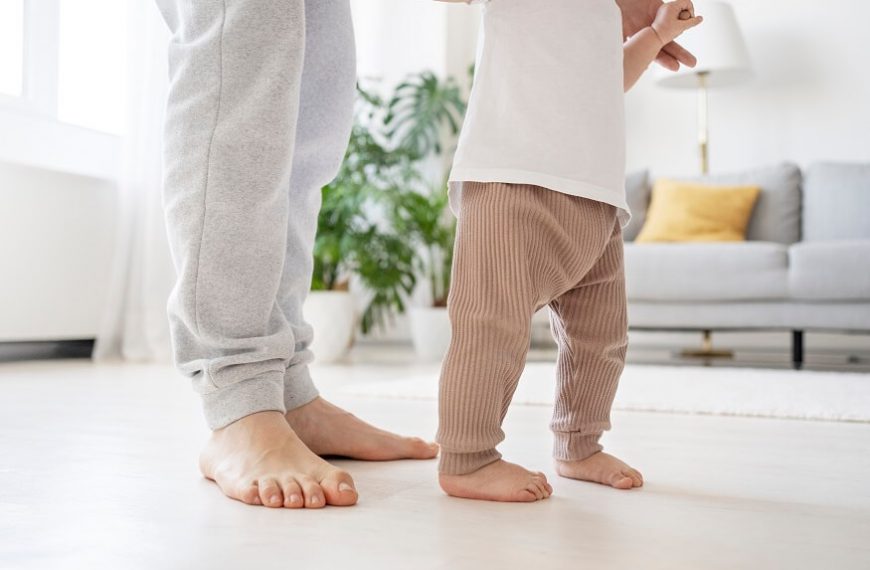At What Age Do Infants Begin to Walk
Some of the most joyful and unforgettable moments of motherhood might be when your kid first starts to walk. Your infant starts building muscular strength at a very young age, gradually getting ready to take their first steps. Your kid will often start to crawl between the ages of 6 and 13. They’ll learn to stand up on their own between 9 and 12 months. And between the ages of 8 and 18 months, they will begin to walk.
One of the many marvelous and unforgettable developmental milestones for your kid is when they start walking. From an early age, your baby has been getting ready to walk. The first steps are your baby’s newest experience after all the rolling, sitting up, bottom shuffling, crawling, furniture cruising, and standing.
Babies often begin walking between the ages of 10 and 18 months. Babies often pull themselves up to stand and begin to crawl between the ages of 7 and 12 months before beginning to walk.
How Babies Develop Walking Skills:
Many abilities, including balance, coordination, standing up, and shifting their body weight from one leg to the other, will be developed in your infant. Each new ability will build on the ones that came before it, better preparing them to begin walking.
Your infant must have mastered a variety of abilities before they can walk, including coordination, balance, standing up, and the ability to transfer their body weight from one leg to the other. Every new ability your baby learns builds on the ones they have already mastered. The abilities your child learns get more complicated as they age.
Your kid was developing their physical strength as they were busy pushing themselves up to stand, cruising between items of furniture, and crawling. Additionally, they were acquiring abilities like balance and coordination, all of which are necessary for walking and, subsequently, running.
When your child first learns to walk, they carry on with this procedure. They could try rising from the ground to standing and then falling back to it. To play, they could alternate between sitting, standing, and walking before squatting. Additionally, all of these exercises improve their balance and muscle strength. They’ll keep working on their walking techniques via practise and experimentation. They could stroll in various paths, across various ground types, and while toting bulky toys.
You’ll never forget the moment you saw your child take their first independent steps. When your infant does begin to walk, it does so in phases that involve these significant developmental milestones:
6 months: Babies begin to sit up independently.
6-9 months: Babies begin to crawl.
9 months: In order to stand, babies start to pull themselves up on objects like the sofa or coffee table.
9-12 months: Babies may begin to grip onto furniture, stand up, and investigate their surroundings.
11-13 months: Your child may start to walk independently at this exciting period.
Remember that every infant is unique and may begin walking sooner or later than what medical professionals consider to be “normal.” The growth of youngsters might vary greatly, and that is quite natural.
Contact your pediatrician if your kid is 18 months or older and hasn’t yet learned to walk or if you have any concerns about their development. Keep an eye out for these indicators of late walkers:
- Your infant does not sit independently or roll over in any direction.
- Your infant cannot bear some weight on its legs.
- Your infant does not make an effort to get your attention by acting in a certain way.
- Your infant does not attempt to speak or babble.
- Peekaboo games don’t seem to fascinate your infant.
Ways to Help Your Baby Start Walking:
The best way to help is to provide a supportive environment for walking, both physically and socially. Together, you can play. When your child is exploring, being with or close to them helps them feel protected and develops their confidence. Encourage independent walking since exercise and movement improve your child’s posture and muscular strength, which will improve their walking and make them ready for running. Starting out, you may place yourself around two meters away from your infant and nudge them towards you.
When they accomplish this, you can extend the distance. They can be encouraged to push a doll pram or a toy cart. You may put up an obstacle circuit with foam shapes or soft cushions to walk over or around after they are comfortable moving around. Create a secure environment in your home by keeping the area around your infant clear as they get more mobile. This will prevent accidents and give them plenty of possibilities to wander and explore. Try the following advice to assist your infant in learning to walk:
- Play Together: You can make your infant feel safer while playing while you are around. In this manner, they feel more confident and at ease when they are exploring.
- Encourage Moving: Your infant will benefit from moving about as they develop the muscles necessary for walking and eventually running. You may do this by squatting down in front of your child, inviting them to come to you with your hands out. It’s common for toddlers learning to walk to fall a few times; it’s all part of the learning process. Even while you can’t prevent every fall for your infant, you can lower the risk of harm. By “baby-proofing” your house and making their area as secure as you can, you may assist them:
- Lock cabinets and doors to help protect your child away from dangerous objects like chemicals.
- Cushion furniture with sharp edges.
- If you want to keep your infant from falling down the stairs, install a child-proof gate.
- Keep pans and other objects on the back of your stove.
Baby Products for Walking:
Baby Walkers: Baby walkers are not advised by medical authorities. Your baby’s leg muscles could not grow properly since using a walker makes moving around simple for your infant. Additionally, a baby may find it simpler to access objects like hot objects or potentially harmful poisons while they are raised up on a baby walker. As a result, baby walkers are even less secure.
Baby Shoes: Do not purchase infant shoes immediately after they walk. Your youngster will enhance their balance and coordination by walking barefoot. Introduce them to baby shoes when they begin routinely walking outside.
What Is Next After Your Baby Starts Walking?
The exciting new stage in your baby’s life is just getting started with their first steps. What else can you anticipate as they grow into toddlers:
14 Months: Your child will probably be able to stand up by themselves at this age, stand back up, squat, and perhaps even walk backwards.
15 Months: Your youngster should be able to walk fairly well and will probably like pushing and pulling objects and discovering new things.
16 Months: Although they will probably still seek to you for assistance with this one, your baby will start to show interest in climbing and descending the steps.
18 Months: Your child will likely master walking by the time they are 18 months old and love moving about independently. They will probably also take pleasure in dancing and climbing on furniture.
Your child will have access to a variety of fresh chances as they become more self-assured and independent. Enjoy this wonderful period while it lasts.














